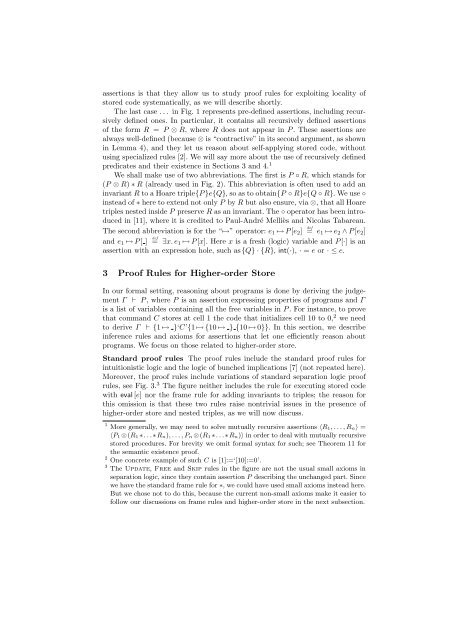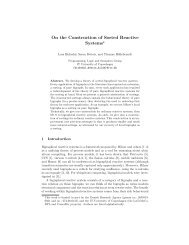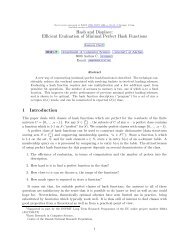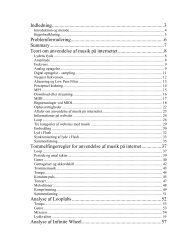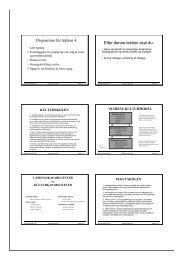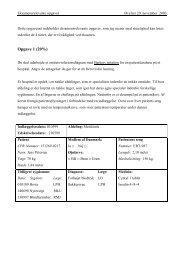Nested Hoare Triples and Frame Rules for Higher-order Store
Nested Hoare Triples and Frame Rules for Higher-order Store
Nested Hoare Triples and Frame Rules for Higher-order Store
You also want an ePaper? Increase the reach of your titles
YUMPU automatically turns print PDFs into web optimized ePapers that Google loves.
assertions is that they allow us to study proof rules <strong>for</strong> exploiting locality ofstored code systematically, as we will describe shortly.The last case . . . in Fig. 1 represents pre-defined assertions, including recursivelydefined ones. In particular, it contains all recursively defined assertionsof the <strong>for</strong>m R = P ⊗ R, where R does not appear in P . These assertions arealways well-defined (because ⊗ is “contractive” in its second argument, as shownin Lemma 4), <strong>and</strong> they let us reason about self-applying stored code, withoutusing specialized rules [2]. We will say more about the use of recursively definedpredicates <strong>and</strong> their existence in Sections 3 <strong>and</strong> 4. 1We shall make use of two abbreviations. The first is P ◦ R, which st<strong>and</strong>s <strong>for</strong>(P ⊗ R) ∗ R (already used in Fig. 2). This abbreviation is often used to add aninvariant R to a <strong>Hoare</strong> triple{P }e{Q}, so as to obtain{P ◦ R}e{Q ◦ R}. We use ◦instead of ∗ here to extend not only P by R but also ensure, via ⊗, that all <strong>Hoare</strong>triples nested inside P preserve R as an invariant. The ◦ operator has been introducedin [11], where it is credited to Paul-André Melliès <strong>and</strong> Nicolas Tabareau.defThe second abbreviation is <strong>for</strong> the “↦→” operator: e 1 ↦→ P [e 2 ] = e 1 ↦→ e 2 ∧ P [e 2 ]def<strong>and</strong> e 1 ↦→ P [ ] = ∃x. e 1 ↦→ P [x]. Here x is a fresh (logic) variable <strong>and</strong> P [·] is anassertion with an expression hole, such as{Q} · {R}, int(·), · = e or · ≤ e.3 Proof <strong>Rules</strong> <strong>for</strong> <strong>Higher</strong>-<strong>order</strong> <strong>Store</strong>In our <strong>for</strong>mal setting, reasoning about programs is done by deriving the judgementΓ ⊢ P , where P is an assertion expressing properties of programs <strong>and</strong> Γis a list of variables containing all the free variables in P . For instance, to provethat comm<strong>and</strong> C stores at cell 1 the code that initializes cell 10 to 0, 2 we needto derive Γ ⊢ {1 ↦→ }‘C’{1 ↦→ {10 ↦→ } {10 ↦→ 0}}. In this section, we describeinference rules <strong>and</strong> axioms <strong>for</strong> assertions that let one efficiently reason aboutprograms. We focus on those related to higher-<strong>order</strong> store.St<strong>and</strong>ard proof rules The proof rules include the st<strong>and</strong>ard proof rules <strong>for</strong>intuitionistic logic <strong>and</strong> the logic of bunched implications [7] (not repeated here).Moreover, the proof rules include variations of st<strong>and</strong>ard separation logic proofrules, see Fig. 3. 3 The figure neither includes the rule <strong>for</strong> executing stored codewith eval [e] nor the frame rule <strong>for</strong> adding invariants to triples; the reason <strong>for</strong>this omission is that these two rules raise nontrivial issues in the presence ofhigher-<strong>order</strong> store <strong>and</strong> nested triples, as we will now discuss.1 More generally, we may need to solve mutually recursive assertions 〈R 1, . . . , R n〉 =〈P 1 ⊗(R 1 ∗. . .∗R n), . . . , P n ⊗(R 1 ∗. . .∗R n)〉 in <strong>order</strong> to deal with mutually recursivestored procedures. For brevity we omit <strong>for</strong>mal syntax <strong>for</strong> such; see Theorem 11 <strong>for</strong>the semantic existence proof.2 One concrete example of such C is [1]:=‘[10]:=0’.3 The Update, Free <strong>and</strong> Skip rules in the figure are not the usual small axioms inseparation logic, since they contain assertion P describing the unchanged part. Sincewe have the st<strong>and</strong>ard frame rule <strong>for</strong> ∗, we could have used small axioms instead here.But we chose not to do this, because the current non-small axioms make it easier tofollow our discussions on frame rules <strong>and</strong> higher-<strong>order</strong> store in the next subsection.


